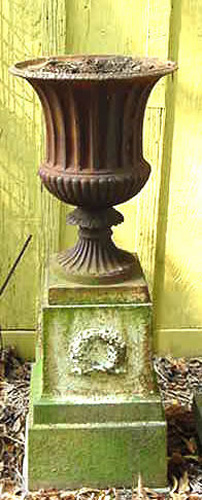
Ready for Winter in the Garden
Protecting your Garden Antiques in Cold Weather
Snow, ice and wind can be very destructive to garden ornaments. Movable statuary should be placed in storage or moved inside if possible. Statues and large urns too heavy to move should be covered with water proof tarps, tightly secured to with stand heavy winds. Make sure your statuary and large planters or urns are on a solid, frost- proof base. They should not be sitting directly on the soil or grass. In colder climates the ground moves and heaves during freezes and thaws which can cause statuary and urns to fall over or sink in the ground. Statues and large urns too heavy to move should be covered with water proof tarps. To prepare a frost-proof base dig a hole 30 inches deep or below the frost line. Make sure that the hole drains well by testing the drainage with a bucket of water. If the drainage is not good, excavate further and fill bottom of hole with six or more inches of gravel. Then fill the hole with crushed stone or concrete. The hole can then be covered with a thick piece of stone or concrete for an attractive base for the piece. Items placed under trees are suseptable to damage from falling limbs from heavy winds. Care should be taken to move pieces away from these locations, if possible. To protect finishes it is always better to store cast iron furniture for the winter. Cracks in cast stone, marble or stone can collect water which will freeze and thaw, causing further damage; therefore, these pieces should also be covered. And yet many collectors enjoy leaving certain special pieces in their garden uncovered which take on a totally new magical appearance when covered with snow in the winter landscape. Bird baths of any material should be stored away or the bowls placed on the ground turned over. Urns or jars of any type also also need attention. Even with drain holes, which get blocked with leaves water can collect and cause damage in freezing weather. They should be turned over if possible or if they are large urns with planting soil, the soil should be allowed to dry out and then the urn covered with a waterproof tarp. Most terra cotta pieces such as oil jars should be given special attention and put in storage in cold climates. The exception to this would be “architectural “ terra cotta pieces of high fired terra cotta, a beige or brown masonary building material which was weather proof and used for many buildings in the late 19th century to 1930.;Decorative exterior fragments from these buildings, often with a ceramic glaze, are popular garden ornaments today and can be safely left outdoors in any weather. The Galloway Terra Cotta Co. established in Philadelphia in 1810 advertised their terra cotta ware as “frost-proof” and fired to a degree that “rendered the body frost-proof and would weather the severest winter.” Fountains should be turned off and the basins emptied and stored if possible. Smaller fountains can be removed and put in storage. Pumps should be removed, the lines drained and cleaned and the pump stored in a plastie bag so the seals do not dry out. If the fountain is not removable, let it dry and then securely cover the fountain with a weather proof tarp. |





